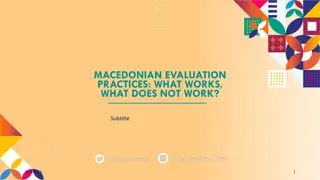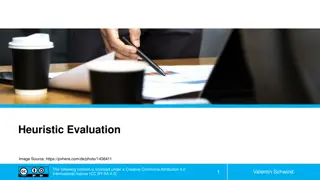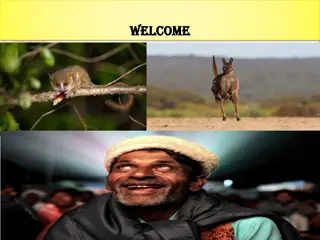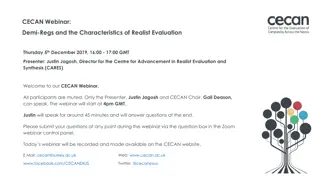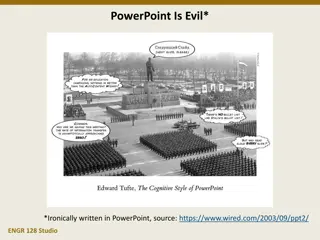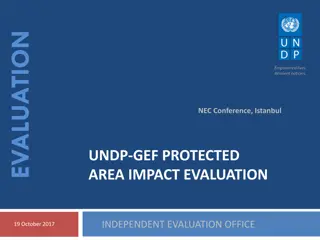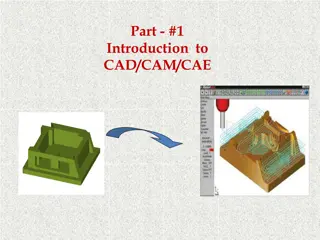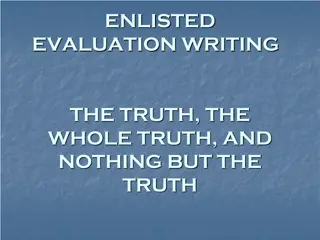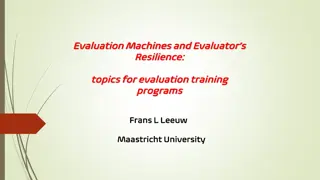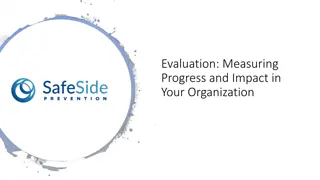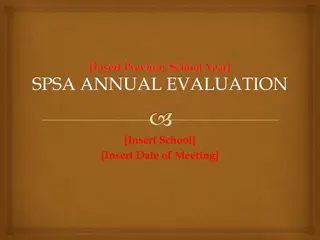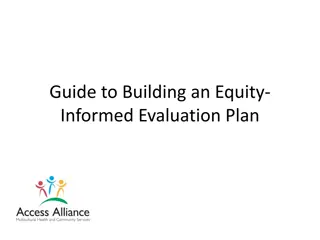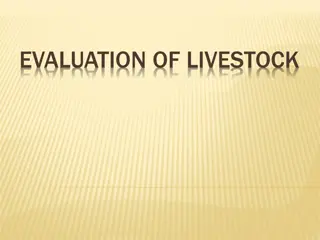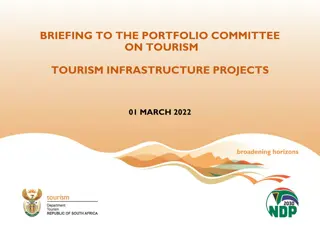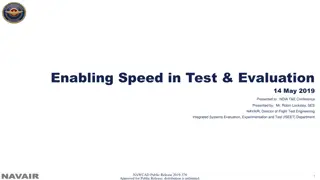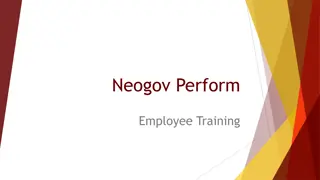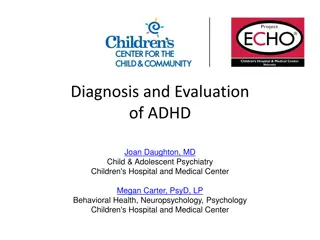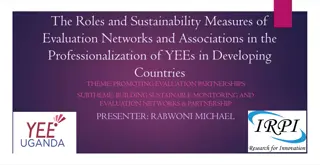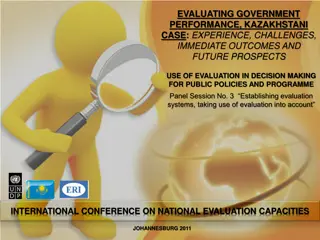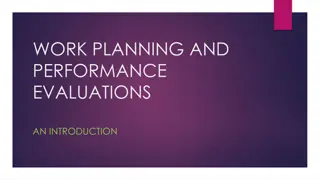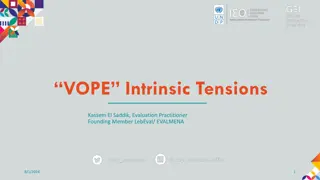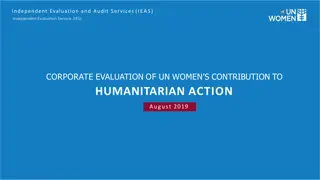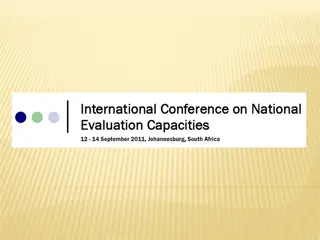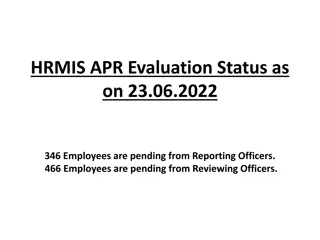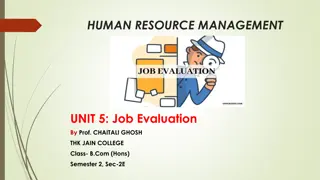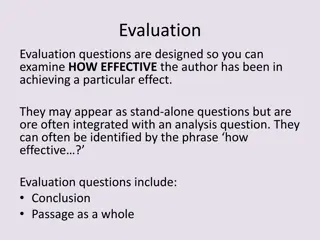Complete Co-design Evaluation Guide for Effective Projects
Ensure project success by co-designing goals and outcomes with stakeholders, incorporating their perspectives throughout the project lifecycle. Understand project needs, desired outcomes, and evidence, keeping stakeholders informed at every stage. Use consultation methods like workshops and forms to involve participants in co-designing the project effectively.
Download Presentation

Please find below an Image/Link to download the presentation.
The content on the website is provided AS IS for your information and personal use only. It may not be sold, licensed, or shared on other websites without obtaining consent from the author. Download presentation by click this link. If you encounter any issues during the download, it is possible that the publisher has removed the file from their server.
E N D
Presentation Transcript
Guide to Co-design Evaluation To be completed at the initiation of a project; during (confirm frequency) and at the completion of the project.
Guide to Co-design Evaluation We want to make sure that the projects at Onemda and the way they are evaluated is co-designed. Co-design in our context means people with a disability and other stakeholders have a say and help design the project goals and outcomes. This icon is a symbol for co-design. It reminds you when you need to consult with participants and other stakeholders. We need to know what an effective project looks like from the perspectives of participants and other stakeholders. This means we need to consult these people when co- designing the project. We need to work with them to find out how will we know whether the project is effective. On each page of this co-design evaluation tool there are instructions on the type of information you need to collect.
Project Evaluation Name of Project: Description: Date of Reviews: Start Date: Expected completion date:
Understanding the Project We need to know what an effective project looks like from the perspectives of participants and other stakeholders. Other stakeholders might include families/carers, Onemda staff, Onemda organisation, community members, NDIA, NDS and other. This means we need to consult these people when co- designing the project. We need to work with them to find out how we will know whether the project is effective.
EVIDENCE OF NEED What is the identified need for the project? What is the evidence to support the design of the project? Who identified the need for the project?
EVIDENCE OF NEED What is the desired outcome of the project? From whose perspective is this the desired outcome? Who thinks this is a good outcome? What are you doing to keep stakeholders informed about this stage of the project?
Co-designing the Project A reminder that in this context co-design means people with a disability and other stakeholders have a say and help design the project goals and outcomes. Co-design requires consultation. This can be done in a number of ways you could fill out this form together, you could run a workshop to gather ideas and then fill out the form, you could talk with them and then fill out the form etc. The most important thing is to not do it alone.
CO-DESIGNING EVALUATION Where is the project to be implemented? Who does it? Who else could be involved?
CO-DESIGNING EVALUATION These tools can be access here: [INSERT HYPERLINK HERE] Will you use a validated tool to measure the outcomes or will you develop your own process? Considerations and questions? Building new data measures? or using existing measures?
What are you doing to keep stakeholders informed about this stage of the project? CO-DESIGNING EVALUATION Co-design how outcome measures will be collected and analysed: What training is needed to collect and analyse data? Is training available? If training is required and not available, talk to your line manager before proceeding with project. What date(s) will you review both how the project is being implemented and what the outcome measures are telling you about how the project is going? TIP: Put date(s) in your diary as a reminder!
CAPTURING SHORT, MEDIUM & LONG-TERM GOALS Every project should meet at least one of Onemda's Strategic Goals; at least one Quality of Life measure; and at least one NDIS domain measure Onemda Quality of Life NDIS Schalock and Verdugo (2012) N-1 Personal Development: Education status; personal skills; adaptive behaviour Deliver outstanding and impactful services which enrich and extend our participants. Domain 1: Choice and control Q-1 O-1 N-2 Domain 2: Daily living Self-determination: Choices/decisions; autonomy; personal control; personal goals Q-2 Grow Onemda s established profile as a trusted and progressive leader within key target audiences. N-3 Domain 3: Relationships O-2 Interpersonal relations: Social networks; friendships; social activities; relationships Q-3 N-4 Domain 4: Home Bring Onemda s unique value proposition to markets in need. O-3 Social Inclusion: Community Integration/ participation; Community roles; supports N-5 Q-4 Domain, 5: Health and wellbeing Optimise organisational capacity to deliver on our vision. O-4 N-6 Domain 6: Lifelong learning Rights: Human (response, dignity, equality); Legal (legal access and due process) Q-5 Continue to build and shape a brilliantly skilled, passionate and high performing workforce. N-7 Domain 7: Work O-5 Emotional wellbeing: Safety and security; Positive experiences; Contentment; Lack of Stress Q-6 Domain 8: Social, community and civic participation N-8 Continue to embed research, innovation and technology into service delivery activities. Q-7 Physical wellbeing: Health & nutrition status; recreation; leisure O-6 Material wellbeing: Financial status; employment status; housing status; possessions Q-8
What are you doing to keep stakeholders informed about this stage of the project? PROJECT OUTCOMES & SUCCESS MEASURES WHAT OUTCOME DO YOU HOPE TO ACHIEVE? WHAT IS THE SUCCESS MEASURE? (Based on consultation with stakeholders) HOW DO WE MEASURE THIS? (Based on consultation with stakeholders) QUALITY OF LIFE STAKEHOLDER S/M/L ONEMDA NDIS Onemda participant
HOW WAS THE PROJECT IMPLEMENTED? The next section of the framework captures what happened when the project was implemented so that we can understand what worked and what didn t work and why. This will help us understand what next steps are appropriate for this project. Describe how the project happens or gets done: Why does it happen like that?
HOW WAS THE PROJECT IMPLEMENTED? Were there unintended consequences of the project? What resources were needed to implement and evaluate the project? (dollars, staff, time, equipment, other) Implementation resources (costs) Evaluation resources (costs) Other comments: What are you doing to keep stakeholders informed about this stage of the project?
SHORT, MEDIUM & LONG-TERM OUTCOMES OUTCOME & MEASURE (What data is being collected?) WHAT ARE YOU GOING TO DO ABOUT IT? WHAT NEEDS TO CHANGE? WHERE IS DATA FOR THIS PROJECT STORED? WHAT DID YOU FIND OUT?
What are you doing to keep stakeholders informed about this stage of the project? WHAT IS NEXT FOR THIS PROJECT? Is the stakeholder enjoying the project? Have they gained anything out of the project? Have there been any changes toward the outcomes they would like to achieve (e.g. movement toward Strongly Agree on a Likert scale)? MOVE TICK INTO APPROPRIATE BOX Continue project without changes Continue project with changes to make it better Discontinue the project Why? How did the outcome and implementation measures inform your decision? If continuing the project how are you going to measure its impact?
FRAMEWORK EVALUATION This evaluation framework has been designed by Onemda and UTS to help disability services to co-design projects and evaluations. We also want to find out whether projects are working from the perspectives of Participants and other stakeholders. You are the first people to pilot this evaluation framework prototype. We are going to use your feedback and experiences to improve this prototype so that it is easier and not too time consuming to use. Use results to reflect on and evaluate the evaluation framework











